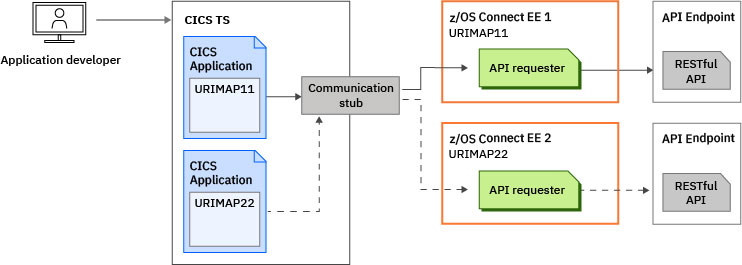Overriding the URIMAP in a CICS application
When a CICS® application is developed to call a RESTful service, the IBM® z/OS® Connect server that is used to process the request can be chosen at run time within the CICS application. This option allows for splitting of workloads between servers, for example, based on business area. This dynamic routing capability is available for CICS applications only.
Overview

The two IBM z/OS Connect servers shown in Figure 1 can have different configurations and support different API requesters. You can still configure multiple servers with the same configuration behind shared ports for work load management.
Parameters for dynamic routing in the request
IBM z/OS Connect provides a data structure to specify the dynamic routing parameters in the request. Two versions of the data structure are provided, a COBOL version called BAQRINFO in <hlq>.SBAQCOB and a PL/I version called BAQRINFP in <hlq>.SBAQPLI.
Ensure that the communication stub request information structure is set with a compatibility level of 3 or higher. The compatibility level value is defined for COBOL by the BAQ-REQUEST-INFO-COMP-LEVEL variable and for PL/I by the BAQ_REQUEST_INFO_COMP_LEVEL variable.
BAQ-REQUEST-INFO. For PL/I, these parameters are defined
in BAQ_REQUEST_INFO. You can specify values for the parameters as required.
| Variables for COBOL | Variables for PL/I | Description |
|---|---|---|
| BAQ-ZCON-SERVER-URI | BAQ_ZCON_SERVER_URI | A URIMAP resource name used to route to a particular IBM z/OS Connect server. The name must be a valid URIMAP resource name of 1 - 8 characters in length. The field size is 256 characters, but this is to accommodate future enhancements. |
The BAQ-ZCON-SERVER-URI field is optional. If the field is left initialized with
spaces, then the default URIMAP of BAQURIMP is used to route the request. If the field is populated,
the URIMAP resource name is validated and used to route the request. If there is a problem with the
URIMAP resource name, or the URIMAP is unknown, unavailable, or links to an unknown host then an
appropriate error message is returned and the request is not processed.
All URIMAP resources to be used must be installed in the CICS region.
Example: Developing a COBOL application to dynamically route to a IBM z/OS Connect server.
The following example demonstrates how to develop a COBOL application to dynamically route to a particular server.
- The request copybook:
API00Q01 - The response copybook:
API00P01 - The API information file:
API00I01
- Include the BAQRINFO data structure.
-
COPY BAQRINFO - Include copybooks.
-
01 REQUEST. COPY API00Q01. 01 RESPONSE. COPY API00P01. 01 API-INFO. COPY API00I01. - Declare variables for the request and response.
-
01 BAQ-REQUEST-PTR USAGE POINTER. 01 BAQ-REQUEST-LEN PIC S9(9) COMP-5 SYNC. 01 BAQ-RESPONSE-PTR USAGE POINTER. 01 BAQ-RESPONSE-LEN PIC S9(9) COMP-5 SYNC. 77 COMM-STUB-PGM-NAME PIC X(8) VALUE 'BAQCSTUB'. - Enter values for the dynamically routed request.
-
MOVE 'Req Data' TO Xtext. MOVE "URIMAP11" TO BAQ-ZCON-SERVER-URI. - Prepare the data for call.
-
SET BAQ-REQUEST-PTR TO ADDRESS OF REQUEST. MOVE LENGTH OF REQUEST TO BAQ-REQUEST-LEN. SET BAQ-RESPONSE-PTR TO ADDRESS OF RESPONSE. MOVE LENGTH OF RESPONSE TO BAQ-RESPONSE-LEN. - Call the communication stub.
-
CALL COMM-STUB-PGM-NAME USING BY REFERENCE API-INFO BY REFERENCE BAQ-REQUEST-INFO BY REFERENCE BAQ-REQUEST-PTR BY REFERENCE BAQ-REQUEST-LEN BY REFERENCE BAQ-RESPONSE-INFO BY REFERENCE BAQ-RESPONSE-PTR BY REFERENCE BAQ-RESPONSE-LEN.